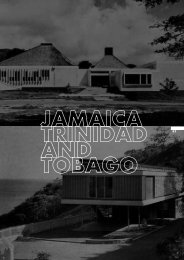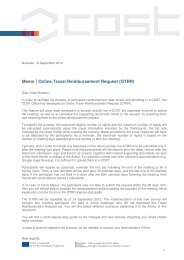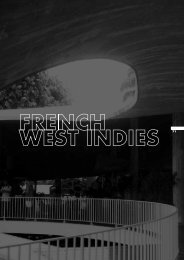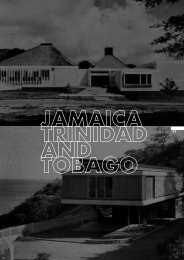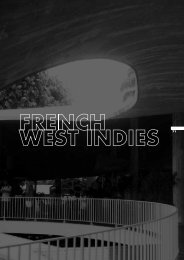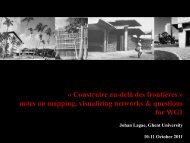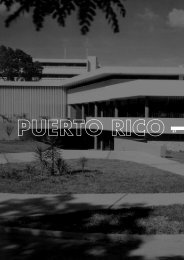PANJIM BETWEEN THE PAST AND MODERNITY
PANJIM BETWEEN THE PAST AND MODERNITY
PANJIM BETWEEN THE PAST AND MODERNITY
Create successful ePaper yourself
Turn your PDF publications into a flip-book with our unique Google optimized e-Paper software.
ARTICLES | 81Para a constituição deste espaço, o conde de TorresNovas teve que aterrar a linha de água e destruiras quatro pontes ali existentes construídas pelovice-rei D. Manuel de Portugal e Castro. Utilizouuma zona para a qual não estavam planeados arruamentos,fazendo a articulação de um tecido entãojá consolidado a nascente com a zona que cresciamais lentamente, a poente. A importância do seuplano refl ecte-se nas palavras de Thomaz Ribeiroquando afi rmou, em 1871, que “Pangim é a cidadedo Conde de Torres Novas (…)”. 56Através do levantamento efectuado em 1870 (verfi g. 6), pode observar-se que a cidade continuoua crescer do lado poente ao longo das ruas que jáexistiam e que seguiam os alinhamentos mais tardeassinalados na planta de 1888.Em 1879, um ano após a sua chegada, o governadorCaetano de Albuquerque descreveu Pangim doseguinte modo: “Pangim é uma cidade onde faltamtodas as condições hygienicas naturaes (…)”. 57 Nomesmo relatório de 1879 dava conta das medidastomadas, de que a melhoria das condições higiénicasera a prioridade. Proibiu a plantação de coqueirosdentro da zona urbana, determinou a construçãode cemitérios e fez publicar regulamentos relativosà construção de casas. 58 Referiu posteriormenteque: “(…) se mandou fazer o aterro marginal (…).Fizeram-se valiosas expropriações, e abriram-senovas ruas com a conveniente orientação e largurapara introduzir ar puro no centro da cidade. (…) amais algumas outras obras de secundária importanciase procedeu, e todas tendentes a melhorar ascondições hygienicas da capital (…).” 59Utilizando as terras provenientes do Corte doOuteiro, foram feitos aterros na marginaldo Mandovi, no Largo Solitário, no Largo daConceição, no Largo do Novo Mercado e no esteirode Santa Inês. Terminava-se assim a maior partedas obras de “modelação” dos terrenos no centroda cidade.Caetano Albuquerque deixou o território goês em1882 e entre essa data e 1888 não se conhecemobras signifi cativas para o desenvolvimento dacidade. As obras planeadas prosseguiam lentamenteenquanto outras prioridades iam surgindo. Em 1887era referido por Fernando Mousinho d’Albuquerque,então director das Obras Públicas, que para além dacontinuação do aterro e construção da muralhamarginal, nenhum trabalho importante tinha sidoWe do not know if this was part of a previousplan. But one can guess that it was an isoloatedplan, because, to carry it out, the Count of TorresNovas had to fi ll in the waterway and destroy thefour bridges built by Dom Manuel. He made use ofa zone for which no new streets were planned toreorganise the city, linking a built-up fabric that wasalready consolidated to the east to the area in thewest that was growing at a slower pace. The importanceof his plan is refl ected in the words of ThomazRibeiro, when he wrote in 1871 that “Panjim wasthe city of the Count of Torres Novas 56” .The survey of 1870 (see fi g. 6) shows that the citycontinued to grow on the western side along thestreets that already existed. They were extended inthe alignments that were later identifi ed in the mapof 1888.In 1879, one year after his arrival, GovernorAlbuquerque described Panjim thus: “Panjim is acity lacking in all natural hygienic conditions” 57 . Inthe same report of 1879, he accounted for the stepstaken, of which improvement in the hygiene conditionswas a priority. He prohibited the plantationof coconut trees inside the urban area, ordered theconstruction of cemeteries and published regulationson the building of houses 58 . He later statedthat: “the marginal landfi ll was carried out (…).Valuable expropriations were effected and newstreets with a convenient orientation and widthwere opened to bring pure air into the centre ofthe city (…). Some other secondary works werealso carried out, all with the aim of improving theconditions of hygiene in the capital“ 59 .Making use of earth from Corte do Outeiro, landfi llswere made along the waterfront of the Mandovi, inLargo Solitário, Largo da Conceição, Largo doNovo Mercado and in the Santa Inês creek. Theseconcluded the greater part of the land “modelling”works in the city centre area.Caetano Albuquerque left Goa in 1882 and wehave no knowledge of any signifi cant works forthe development of the city being carried outbetween that year and 1888. The planned worksprogressed slowly, while other priorities emerged.In 1887 Fernando Mousinho d’Albuquerque, thethen Director of Public Works, wrote that, beyondcontinuing the landfi ll and the construction of thewall on the riverfront road, no important workshad been carried out that year in the capital, givenPanjim between the past and modernityJuly 2007 | MURPHY 2



